 Eastern Mojave Vegetation
Eastern Mojave Vegetation
Tom Schweich
 Eastern Mojave Vegetation
Eastern Mojave Vegetation
| Autecology of Desert Elkweed Frasera albomarginata S. Watson (Syn: Swertia a.) Gentianaceae in the American Southwest (Continued) |
|
Tom Schweich |

Topics in this Article: Introduction Literature Review Field Work and Methods Results Taxonomy Distribution Growth Habits Relationships to Soils and Other Plants Life History Discussion Summary Literature Cited Appendix A -- Field Data Communications Received. |
|
||||
|
|
Growth Habits | ||||
| F. albomarginata is a forb, meaning that it is a perennial plant that does not form woody tissue above ground. During unfavorable times, the above-ground parts of F. albomarginata will wither and dry-up. In the eastern Mojave Desert, the unfavorable time could be summer, winter, or both. The underground part of F. albomarginata is a fairly bright yellow tap root, with few branches. The root will also occasionally fork just below the soil surface, resulting in two centers of above-ground growth. F. albomarginata flowers once and then dies, to which the terms semelparous and monocarpic are often applied. | |||||
|
|
Relationships to Soils and Other Plants | ||||
|
|
Relation to Soils | ||||
| Frasera albomarginata is found in open places on rocky soils derived from limestones. On the north face of Wild horse Mesa and around Pinto Mountain, the soil is formed from a fresh water limestone informally called the "Winkler Formation." | |||||
|
Locations:
Wild Horse Mesa.
|
The photograph at left is a view of my experimental plot on the north face of Wild Horse Mesa. The soil here is formed from the Winkler Formation. There is loose rock on the soil surface, under which is a large fraction of powdery soil. The Winkler Formation has some resistent ledges as can be seen in the lower right of the photograph, but above and below the ledge is a softer rock that forms the powdery soil. | ||||
| The species is sometimes found in washes downstream from the Winkler Formation, in places where the primary rock type is the slightly acid Peach Springs tuff. For sure, this is because the seeds have been washed down from above. But I also suspect that runoff from the carbonate-based Winkler Formation has altered the chemistry of the wash thus enabling the species to grow there. | |||||
|
Locations:
Caruthers Canyon.
Giant Ledge Mine.
|
This photograph shows a location in Caruthers Canyon, New York Mountains where the species is common. This is an open slope facing southwest in the Pinyon-Juniper Woodland near the Giant Ledge Mine. The slope faces the southwest. The species is found mostly in the open area, with a few individuals in the edges near the shrubs and trees. Other common species here are Pinus monophylla, Juniperus osteosperma, Eriogonum fasciculatum, and Ceanothus greggii. | ||||
| Frasera albomarginata is also found in disturbed areas around the Giant Ledge Mine, such as the edges of the mine dumps, and on the former roads and trails. | |||||
|
Locations: Clark Mountain. Spring Mountains. |
Frasera albomarginata is also found at Clark Mountain and in the Spring Mountains, near Las Vegas, Nevada. Those mountains consist mostly of Paleozoic marine limestones and dolomites. However, no published accounts or herbarium specimen vouchers note affinity of F. albomarginata for limestones or other carbonate rocks. I find the Mid Hills sites interesting because F. albomarginata is growing on Tertiary lacustrine, or non-marine, sediments, rather than Paleozoic marine limestones and dolomites of the other reported sites. | ||||
|
Locations:
Beaver Dam Mountains.
|
This is a general view of an area in the Beaverdam Mountains, Utah, where the species is common. This location is on the road to Hell Hole Pass, north of the old road to Saint George. The soil is developed from small broken stones of limestone. Species common here are Ephedra viridis, Pinus monophylla, Juniperus osteosperma, Artemisia tridentata, Berberis sp., Quercus gambelli, and Purshia glandulosa. | ||||
|
Locations:
Apex Mine.
|
The species can also grow in sandy soils, as shown in the photograph at left.
This photograph was taken on Powerline Road, Mine Valley,
Beaverdam Mountains at about 1350 m elevation.
This location is also on the Mojave Desert / Joshua Tree Road, and
east of the Apex Mine.
The soil here is very red and sandy, and is perhaps alluvium from the Navajo Sandstone. However, the sandy soil is also "stiff" or "crunchy." I suspect there is a substantial component of limestone in the sand. Indeed, above this location there is massive limestone above the sandstone strata. I have found the species growing in other similar situations, i.e., non-limestone soils downstream from limestone, in other locations as well. The two little shrubs to the left are Basin Sagebrush (Artemisia tridentata). The other main plant associate of the species at this location is Utah Juniper (Juniperus osteosperma). Note also the tire tracks in the upper left. There were enough tire tracks and other signs of distrubance to classify this as a "disturbed site." | ||||
|
Locations:
Giant Ledge Mine.
|
Here is one exception to the soil relations explained above. These are two plants growing in a fracture in granite. The picture was taken at the Giant Ledge Mine in Caruthers Canyon. While the outcrop is apparently granite, it is also very close to the contact between the granite and the limestone that it was intruding. Notice the coloration of the rock and the large crumbly grains. Therefore, it may be that the chemistry of the granite has been altered to contain a substantial fraction of limestone constituents. | ||||
|
Locations:
Giant Ledge Mine.
|
Also found near the Giant Ledge Mine, this specimen of Frasera albomarginata shown in the photograph at left was growing in shade on the edge of an incised watercourse. Originally, I thought that I had found a specimen growing in a rock outcrop. On closer inspection, though, I discovered that there is quite a bit of soil between the cobbles, and that only the deep shade of the overarching shrub makes this an unusual location for the species. | ||||
| Cryptogamic soils that have a crust of algae and lichen are found occasionally in the desert. They seem to form on very stable soils under or around long-lived shrubs such as Basin Sagebrush (Artemisia tridentata) and Blackbrush (Coleogyne ramosissima). It is generally believed that cryptogamic soils are easily damaged by foot or hoof traffic and take many years to regenerate. | |||||
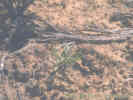 F. albomarginata growing in a cryptogamic soil. F. albomarginata growing in a cryptogamic soil.
|
Frasera albomarginata does not seem to have an affinity
for cryptogamic soil.
However, as Figure 26 shows, the species is not excluded by them either.
A individual of Basin Sagebrush (Artemisia tridentata) is just barely seen in the upper left corner of the picture, and is the source of the decaying wood across the top. I suspect that this shrub was formerly much larger and the cryptogamic soil developed underneath it. The shrub has experienced some die-off, hence the wood laying on the ground, and this has opened up an area for the Frasera albomarginata to colonize. Notice how, on the right hand size of the photograph, the cryptogamic soil has begun to degenerate and break apart. | ||||
|
|
Plant Associates | ||||
|
A plant list for Lobo Point and North Wild Horse Mesa is published at this WWW site.
Generally, F. albomarginata grows in open places where the soil is otherwise bare.
Immediately around my experimental plots are scattered Pinyons and Junipers.
The Wild Horse Mesa plot has one California Buckwheat growing in the plot.
Otherwise, though, the soil is bare in the immediate vicinity of F. albomarginata.
I have an impression, formed by driving around the southwest looking for F. albomarginata, that it is more likely to be found where there are more junipers than pinyons, the grass is quite sparse, and some bare ground is to be found. | |||||
|
|
Life History | ||||
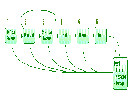 Diagram of possible Frasera albomarginata life cycle. Diagram of possible Frasera albomarginata life cycle.
|
The seven life cycle stages of F. albomarginata may be diagrammed as follows: | ||||
|
|
GerminationSince the plots were established in April 1996, eight seedlings have established in the two plots. I have recognized these as new rosettes, not as seedlings with cotyledons. | ||||
|
Literature Cited:
|
In the garden, F. albomarginata does not germinate easily. My early experiments of placing seeds outdoors in a variety of soils all failed with no germination. Deno (1993) noted that, even with a variety of treatments, only a small percentage of Frasera [Frasera] seeds germinate in a given season. | ||||
| Experiments with seed germination under different soil conditions and cold layering have yielded no useful information. The recent seasons, 1996-1997, were poor for seed development, and very few seeds were available for collecting. Of those available, I am reluctant to collect more than a few. I did collect 215 seeds and divided them into 5 groups of 43 seeds each. Two groups were planted outdoors in November 1996, one group in soil from North Wild Horse Mesa, and the other in a commercial potting mix. The other three groups were refrigerated for three months. Two of them were planted outdoors in March 1996, one group in soil from North Wild Horse Mesa, and the other in a commercial potting mix. The fifth group is sitting on my desk in an envelope. | |||||
| So far no seeds have germinated. There was no seed to collect in the field in 1997. | |||||
| Anecdotally, I believe very fresh seed to germinate immediately. However, I have been unable to reproduce this result due to the unavailability of fresh seed. | |||||
| A low germination rate would seem to provide survival value to a semelparous species, especially in a marginal environment such as the eastern Mojave. | |||||
|
|
Seedling EstablishmentSuccessful seedlings appear to establish and form rosettes quickly. I have observed eight new rosettes in the field, seven of which established in a six-week period, from March 14, 1998 to April 29, 1998. This implies that seedlings grow rapidly once germination occurs. | ||||
|
Other articles:
|
Early Growth StageEarly leaves are thin and tend to be folded like those in Figure 29. Later, when the plant is better established the leaves will unfold almost to the point of being flat. | ||||
|
Other articles:
|
Establishment | ||||
|
Other articles:
|
DormancyPlants have been observed to be dormant in all four seasons. Generally, though a plant thought to be dormant in late-April and May will eventually be found to be dead. On the other hand I have numerous instances of plants dormant in Fall, and then reappearing the next Spring. Most plants are dormant in Winter, and recognized only by the presence of dry shriveled brown leaves near the stake. | ||||
|
Other articles:
|
Budding
| ||||
|
Other articles:
|
Flowering
| ||||
|
Other articles:
|
Seed
| ||||
|
|
Collecting SeedSeed is fairly easy to collect. In the eastern Mojave, seed begins to ripen in June, and remains loose in septicidal capsules well into the Fall. | ||||
|
|
Grazing EffectsI have noticed some instances of herbivory at Pinto Mountain, but not North Wild Horse Mesa. However, a greater danger from herbivores is physical damage. Four of 37 specimens staked at Pinto Mountain were damaged by cattle hoof prints in the period April to October, 1996. I suppose this could be termed bovipodal extermination. At North Wild Horse Mesa, numerous deer hoof prints were noted, with no damage to staked plants. | ||||
|
Other articles:
|
|||||
|
|
Discussion | ||||
|
Locations:
Carson Pass.
Winnemuca Lake.
|
Within the American species of Frasera, there is only one species with published ecological data. That species is Monument Plant (Frasera speciosa, Syn: Swertia radiata). The species is found in the mountains of the western Cordillera. The photograph at left was taken on the trail to Winnemuca Lake, near Carson Pass, in the Sierra Nevada of California. | ||||
|
Literature Cited:
|
Some of the floras, e. g., Kartesz (1988), suggest that the desert species of Frasera evolved from Frasera speciosa. Those sources do not publish the data, or the logical analysis, that would lead one to that conclusion. | ||||
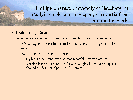 Research of the genus Swertia by Phillipe Chassot. Research of the genus Swertia by Phillipe Chassot.
|
Recently, though, I have sent plant material of Frasera albomarginata to Phillipe Chassot at the University of Neuchatel. While the data is unpublished, it appears that the American Frasera evolved from one ancestor, and that ancestor was most similar to Frasera speciosa. | ||||
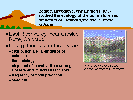 Summary of Literature. Summary of Literature.
|
If Frasera albomarginata evolved from S. radiata then the latter species may serve as a model for F. albomarginata and a control point for differential evolution to the desert environment. | ||||
|
Literature Cited:
Locations: Crested Butte. East River Valley. |
Beattie, Breedlove, and Erlich (1973) studied the ecology of the pollinators of Frasera speciosa. In the East River Valley, near Crested Butte, Colorado, they studied the species over a period of three years and gathered data on the distribution and abundance of colonies, floral biology, dispersal of insect visitors among Frasera and its floral associates, frequency of floral associates, and seed set. | ||||
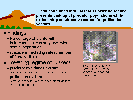 Summary of Literature. Summary of Literature.
|
Beattie et al. found that the percentage of plants with
infloresences was very low and that they were widely separated
spatially.
They also found that S. radiata attracted the greatest number
of floral visitors.
Beattie et al. concluded that S. radiata's flowering regime prevents buildup of predator populations while maintaining an attractive source for pollination vectors. | ||||
|
Literature Cited:
|
In a separate study, Taylor and Inouye (1985) followed the life histories of over 5,000 individual plants, also in the East River Valley near Crested Butte, Colorado, over a nine year period, from 1973 to 1982. They estimated the mean ages of flowering plants to be 37-43 years. While flowering appears to be synchronized at four year cycles, there also appears to be other cycles. They also found that S. radiata flowers are preformed at least three years in advance of flowering, but that the causes of floral initiation are not clear. | ||||
| My preliminary data appears to show that F. albomarginata blooms when precipitation has allowed sufficient accumulation of resources, and that the species can be very opportunistic, even behaving like a biennial, rather than a perennial forb. | |||||
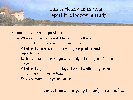 Interim report. Interim report.
|
This is clearly an interim report in an long-term study.
I have waited since 1993 for the newly established plants to flower. It now looks like 1999 will be the year; but the winter of 1998-1999 was cold and very dry. Will the plants trying to flower succeed? Or will they dry out and die before flowering and setting seed? Is there a relationship between precipitation and reproduction for F. albomarginata in the eastern Mojave? Is this relationship stronger in the eastern Mojave, at the edge of the species natural range? Is the pollination biology of F. albomarginata similar to that of S. radiata? What about seed dormancy and germination? Will there be enough seed set in the 1999 flowering season to permit germination studies? | ||||
|
|
SummaryFrasera albomarginata is a attractive, delicate-appearing forb that appears to be restricted to carbonate-based soils in the eastern Mojave Desert. Freezing winters with snow the primary source of precipitation, and long, hot, dry summers, with an unpredictible cloudbursts, present unique challenges for a plant whose family -- Gentianaceae -- is normally associated with mild, moist climates. Being semelparous, F. albomarginata must establish and maintain a seed bank in the soil that can maintain the species over several "bad" years. Its presence adds to the beauty of the desert experience, and its ecology should be instructive in how organisms cope with a difficult and unpredictable desert environment. | ||||
| [Previous Page] [Next Page] | |||||
| If you have a question or a comment you may write to me at: tomas@schweich.com I sometimes post interesting questions in my FAQ, but I never disclose your full name or address. |
Date and time this article was prepared: 5/12/2025 2:58:44 PM |
||||